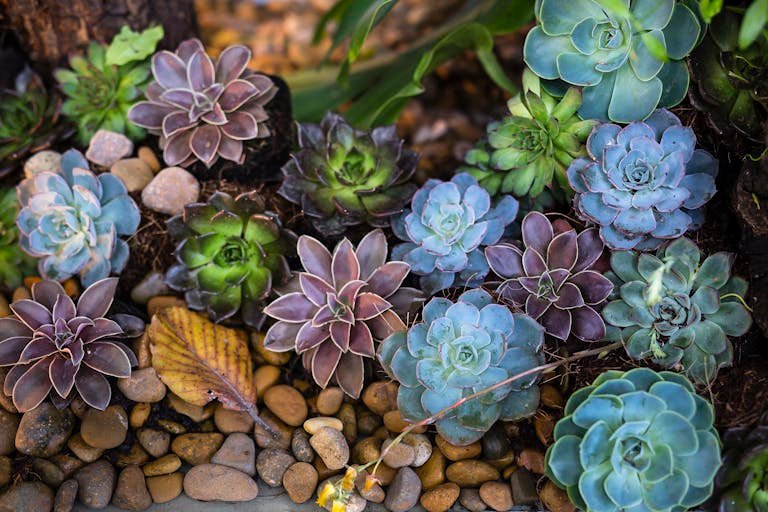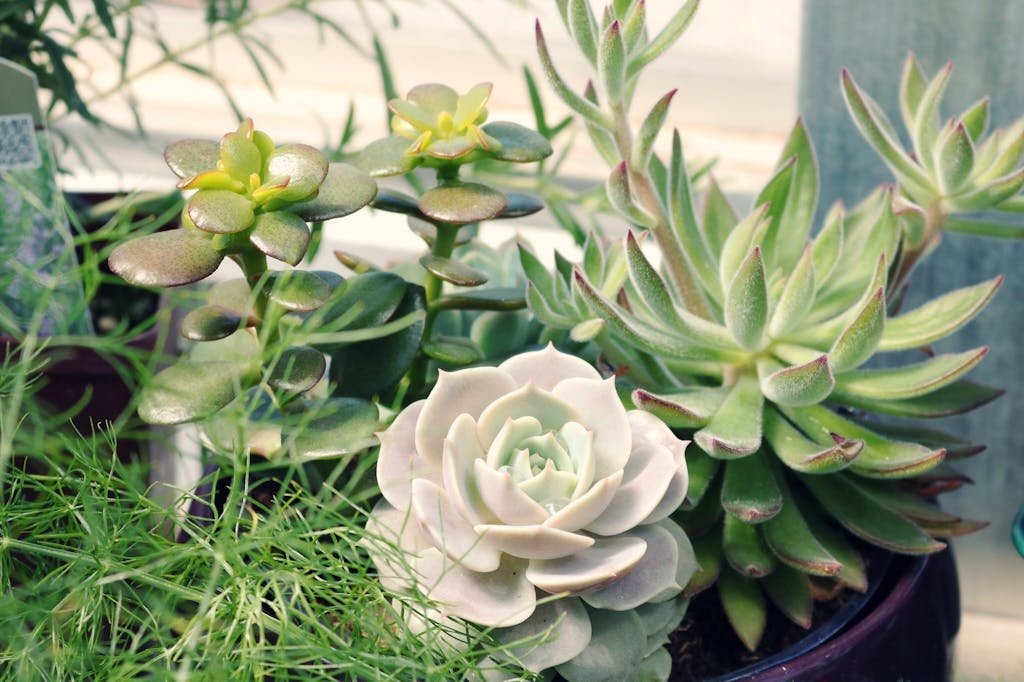
This post includes some affiliate links. Should you click an affiliate link and make a purchase I may receive a small commission at no extra cost to you.
Introduction to Echeveria Plants
What is Echeveria?
Echeveria is a stunning, rosette-forming succulent that steals the show with its symmetrical beauty and wide color palette, from powdery blues and silvery greens to bold pinks and purples. Native primarily to semi-desert regions of Central America, South America, and Mexico, Echeveria belongs to the Crassulaceae family—a group well known for their drought tolerance and low-maintenance habits. With thick, fleshy leaves designed to store water, Echeveria is both resilient and a visual delight, making it a staple in succulent collections worldwide.
Beyond just their looks, these plants are prized for their adaptability and straightforward care routines. Whether planted in cute pots on a sunny windowsill or integrated into dramatic rock gardens outdoors, Echeverias prove that beauty doesn’t have to come with a headache.
For those new to succulents, a comprehensive gift kit like the Succulent box’s Gift Kit can simplify the process.
Brief History and Origin
Named after the 18th-century Mexican botanical artist Atanasio Echeverría y Godoy, Echeverias have been captivating plant enthusiasts for centuries. Indigenous to high-altitude regions, they evolved to endure harsh sunlight, droughts, and cool nighttime temperatures. Early explorers and botanists were fascinated by their rosette form, reminiscent of flowers, and quickly introduced them to Europe and beyond.
In the Victorian era, the craze for exotic and resilient plants sparked Echeveria’s popularity as part of ornamental collections. Today, with over 150 recognized species and countless hybrids, Echeveria continues to evolve, offering even more variety to collectors and casual growers alike.
Why Echeveria is So Popular
Their vibrant colors shift with the seasons and sun exposure, and their petite size makes them ideal for creative plantings. You can use them in fairy gardens, wedding bouquets, modern indoor planters, or expansive outdoor xeriscapes. Plus, Echeverias propagate easily, so one small plant can quickly turn into a flourishing collection without breaking the bank.
They’ve also captured hearts thanks to their symbolism—Echeverias represent endurance, strength, and timeless beauty, making them meaningful gifts as well.

Plant Profile
- Botanical Name: Echeveria spp.
- Common Names: Echeveria, Hen and chicks, Mexican snowball
- Family: Crassulaceae
- USDA Zone: USDA zones 9-11 (varies by species)
- Origin: Native to Mexico and Central America, with some species found in South America.
Echeveria is a stunning, rosette-forming succulent with symmetrical beauty and a rainbow of colors. With thick, fleshy leaves designed to store water, it’s both beautiful and low maintenance. From window sills to rock gardens, Echeveria brings visual delight wherever it grows.
Brief History and Origin
Named after 18th-century botanical artist Atanasio Echeverría, this succulent hails from semi-arid regions in Central and South America. It has evolved to handle harsh climates and minimal water, making it a popular ornamental plant worldwide.
Why Echeveria is So Popular
People love Echeverias because they’re easy to care for, visually stunning, and versatile in both indoor and outdoor spaces. Their low-maintenance nature and ability to propagate easily make them ideal for beginners and collectors alike.
Understanding Echeveria’s Natural Habitat
Native Climate and Environment
Echeverias are used to full sun, rocky soil, and little rainfall. Mimicking these conditions is the secret to growing them successfully at home.
Adaptations That Make Echeveria Unique
From waxy leaves that reduce moisture loss to rosette shapes that collect water, Echeverias are built for survival in tough climates.

How to Grow Echeveria Successfully
Light Requirements
Echeverias need 6+ hours of direct sunlight daily. Indoors, a south-facing window is best. Lack of light causes stretching and dull colors.
Ideal Soil Types
Use well-draining cactus/succulent mix or create your own using potting soil, sand, and perlite. Always use pots with drainage holes.
Pot Size and Repotting Tips
Choose pots slightly larger than the root ball. Repot every 2–3 years in fresh soil to encourage growth and check for rot.

Temperature and Humidity Preferences
Ideal temperature is 65–80°F. Keep humidity low and protect from frost. Bring indoors if it drops below 45°F.
US Plant Hardiness Zones for Echeveria
Echeverias are hardy in USDA Zones 9–11. In cooler zones, grow them in containers to bring indoors during winter.
Watering Echeveria Properly
How Often to Water
Water only when the soil is bone dry. Every 1–2 weeks in summer, and once every 3–4 weeks in winter.
Signs of Overwatering and Underwatering
Overwatering = mushy, yellow leaves. Underwatering = wrinkled, shriveled leaves. Adjust accordingly.
Best Watering Techniques
Use the “soak and dry” method. Water at the base, not over the leaves. Avoid letting it sit in water.
Propagating Echeveria Like a Pro
Leaf Cuttings
Twist off a healthy leaf, let it callus, then place on soil. Mist lightly. New roots and a baby rosette will grow in weeks.
Offsets (Pups)
Remove small baby plants growing at the base. Let them dry, then plant in new pots.

Stem Cuttings
Cut a stretched rosette and let the stem dry before replanting. The leftover stump may also grow pups.
Seeds
Slow but effective for large batches. Sow on soil, mist lightly, and cover until they germinate.
Fertilizing
Feed echeverias sparingly with a diluted, balanced liquid fertilizer during the growing season (spring and summer) to promote healthy growth.
Best Companion Plants for Echeveria
Other Succulents
Great companions include Sedum, Crassula, Haworthia, and Graptopetalum. Choose those with similar care needs.
Companion Plants for Design
Add texture with dwarf agaves, aloe vera, or ornamental grasses like blue fescue.
Companion Plants for Pest Control
Using Echeveria Creatively
Indoor Decor Ideas
Perfect for windowsills, terrariums, wall-mounted pots, or tabletop bowls. They fit nearly any decor style. Use ceramic planters to plant the succulents into. You can also use these nifty watering bottles which allows you to easily irrigate directly to the root of the stem, without wetting the plant surface and staining your desktop. Or use the self watering globes which help you measure how much water your succulent is getting and looks after your plants watering needs while you are away!
Outdoor Landscaping Ideas
Ideal for xeriscapes, rock gardens, and sunny borders. Use gravel mulch for clean lines and moisture control.
Gifts and Event Decoration
Perfect for weddings, birthdays, and home decor. Use them as eco-friendly favors or bouquet accents. Succulent Box has great idea for a gift subscription service whereby they deliver say one succulent as an example for 6 months. This is a great idea and everyone I use this for always loves the idea as they get a good selection of succulents over the subscription period.
Common Pests and Diseases in Echeveria
Common Insect Pests
Watch for mealybugs, aphids, spider mites, and fungus gnats. Treat early with neem oil or rubbing alcohol.
Typical Diseases
Root rot, mildew, and leaf spots are the most common. Fix with better drainage, air flow, and less watering.
Natural and Chemical Treatments
Use neem oil, cinnamon, or alcohol for natural control. Chemical treatments should be a last resort.

Soil Preparation and Fertilization
Best Soil Mix Recipes
Try 2 parts potting soil, 1 part sand, and 1 part pumice or perlite. Avoid moisture-retaining mixes.
The succulent soil that I found works best for my succulent collection is the Succulent Boxes potting soil. My succulent collection seems happiest in this soil medium.
Fertilizer Types and Schedules
Feed lightly with a diluted succulent fertilizer in spring and summer. Don’t fertilize in winter.
Seasonal Care Tips for Echeveria
Winter Care
Bring indoors, reduce watering, and keep in bright light. No fertilizer during dormancy.
Summer Care
Water more frequently, watch for pests, and protect from extreme afternoon sun.
Transitioning Indoors and Outdoors
Move gradually to avoid shock. Always check for pests before bringing indoors.
Troubleshooting Common Echeveria Problems
Leaf Drop
Often caused by overwatering or sudden environmental changes. Adjust care as needed.
Color Changes
Good stress brings vibrant hues. Faded colors may mean low light. Yellowing can mean too much water.
Etiolation (Stretching)
Caused by low light. Move to a brighter location or use a grow light.
Choosing the Right Echeveria for Your Space
Popular Echeveria Varieties
Top choices include ‘Lola,’ ‘Perle von Nurnberg,’ ‘Agavoides,’ and ‘Black Prince.’
Choosing Based on Size and Color
Compact varieties are great for desks. Larger or colorful ones make stunning focal points.
How to Revive a Struggling Echeveria
Diagnosing the Problem
Look for rot, pests, stretching, or shriveled leaves. Determine if it’s light, water, or soil related.
Step-by-Step Recovery Plans
Cut out rot, increase light, adjust watering, or propagate new growth. Be patient.
Fun Facts About Echeveria
Symbolism and Meaning
Echeveria represents strength, endurance, and timeless beauty. A modern symbol of resilience.
Fun Trivia
Pollinated by hummingbirds in nature
Can live 10+ years
NASA has studied succulents for space travel!

Conclusion
Echeveria is more than just a trendy succulent—it’s a versatile, resilient, and beautiful addition to any plant collection. With the right light, soil, and watering habits, your Echeveria will thrive indoors or out. Learn its rhythm, and you’ll be rewarded with long-lasting, low-maintenance charm.
Explore a variety of Echeveria species available at Succulents Box to expand your collection.
FAQs
How fast does Echeveria grow?
Slow to moderate. Indoors it grows slower, especially in the winter
Can Echeveria survive without sunlight?
No. They need bright light to thrive and keep their shape.
How fast does Echeveria grow?
Slow to moderate. Indoors it grows slower, especially in winter.
What’s the easiest Echever
‘Lola’ and ‘Elegans’ are resilient and beginner-friendly.
How do I make my Echeveria bloom?
Provide full sun, fertilize lightly in spring, and let it rest during winter.



